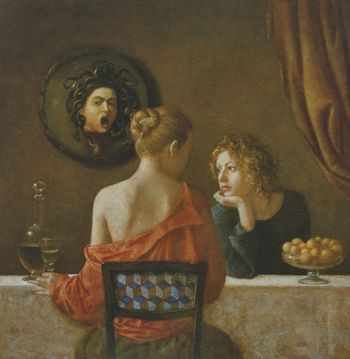Discover Cubist Portraits for sale. Take your pick from an inviting mix of hand-selected portraits by up-and-coming artists such as Eva Humphrey Lahti, Sue McQueen and Mazen Khaddaj.
For drawing, collage or mixed-media portraits, Red Dress by Sue McQueen is worthy of attention. Inspired by the intricate, everchanging nature of both landscape and reality, her pieces have an eerie dreamlike quality which invites the viewer to look beyond the surface of her work.
In contrast, compare the use of acrylic and charcoal on paper in Marko Carving 2 by Eva Humphrey Lahti. Her vigorous and versatile portraits capture the very essence of cubist art; spontaneous, in motion and multiperspective.
A brief history of Cubism
Cubist artwork is generally identified by a visual exploration of multiple viewpoints, a fragmented subject, and the use of objects made from geometric or cube-like shapes. The style began as an avant-garde art movement at the beginning of the 20th century, which essentially reinvented European painting and sculpture. In simple terms, Cubism is the rejection of a single perspective in art and the simplification of form.
The movement was spearheaded by artists such as Pablo Picasso and Georges Braque, who were inspired by the electric energy and vitality of Paris in the 1900s. Similar to the guiding principals of the Abstract movement, cubists attacked conventional standards of art. They decided that art needed to evolve to reflect the modern world, no longer simply serving to copy nature or reality. Like the new technologies radically stretching and modernising our means of travel and communication, the potential of artistic expression needed to expand too.
Types of Cubism
There were two types, or stages, of Cubism: Analytical Cubism (pre-1913) and Synthetic Cubism (post-1913). Analytical Cubism, the first stage, saw artists break down subject matter into blocks and reconstruct it from various viewpoints. For example, in Pedestal Table (1911) by George Braques.
Synthetic Cubism, the second stage, welcomed new materials into the composition. In Synthetic cubist work, artists use a collage of papers, newspapers and other quotidian items to represent said blocks or perspectives. For example, in Still Life before an Open Window (Place Ravignan) (1915) by Juan Gris.
The influence of Cubism on modern art and design can still be felt today, having paved the way for several later pioneering movements such as Futurism, Constructivism and Expressionism. Contemporary artists continue to explore and express the speed at which modern life accelerates with every new technological advancement or socio-cultural shift.











































